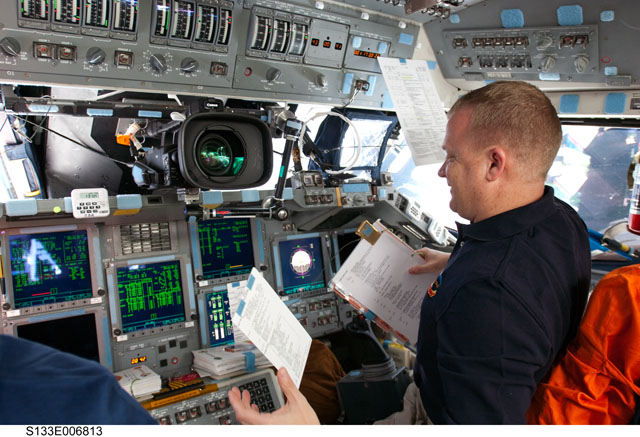
“It’s great to have the opportunity to participate in the space program,” astronaut Eric Boe told an interviewer on the eve of STS-133, the final flight of Shuttle Discovery, in February 2011. “It hasn’t been that many years ago that we walked on the Moon and, here we are with a fully completed space station. There’s many exciting things happen in space and we’re looking forward to exploration that we know is going to happen in the future, going back to the Moon and on to Mars and on to a lot of other different bodies out in the galaxy and on into the Universe.” And for Boe, who turns 50 today (Wednesday, 1 October) and has been for the past two years Deputy Chief of the Astronaut Office, he has a front-row seat and a very personal involvement in the post-shuttle transition toward what might be labeled “The Exploration Era,” as NASA moves toward Commercial Crew and its first missions beyond low-Earth orbit in almost five decades.
Eric Allen Boe was born in Miama, Fla., but grew up on the north side of Atlanta, Ga., and it was the Apollo 11 Moon landing in July 1969—when he was less than five years old—which first drew his attention to a pair of white-clad figures, bouncing around on an alien world. “That kind of put a little nugget in my brain to think about doing that in the future,” Boe later told a NASA interviewer. “I was also very interested in aviation. My father was a pilot in the Air Force, so I grew up around airplanes and going to air shows and seeing different things.”
The young boy also developed an early love of learning and, particularly, of mathematics. “The reason I enjoyed it is that it was something concrete that I could kind of get my hands around and there was an answer,” he reflected. “You had a specific answer to a problem that was put in front of you. The other thing I liked about math was how it integrates with a lot of other fields, so, like a lot of things in science, just by understanding the math that’s involved, you can kind of get to the solutions that you’re trying to get to in science.” Thinking back upon his childhood, Boe remembered his mother taking him to the library. “That sounds like a very small thing,” he acquiesced, “but it was the interest in school and as I grew up to actually go read books or when I had some kind of report in school, we would go.”
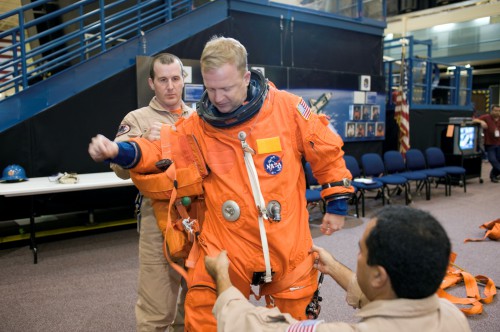
Outside school, he became a cadet in the Georgia Wing of the Civil Air Patrol, earning the coveted General Carl A. Spaatz Award, and upon graduation from Henderson High School in Chamblee, Ga., in 1983, he entered the Air Force Academy to study astronautical engineering. Upon receipt of his degree—and with the added accolade of Distinguished Graduate—in 1987, Boe was commissioned into the Air Force and completed Euro-NATO Joint Jet Pilot Training at Sheppard Air Force Base in Wichita Falls, Texas. He then moved to Clark Air Base in the Philippines as a combat-ready fighter pilot, flying the F-4E Phantom II, and later served as an instructor in the T-38 Talon trainer at Columbus Air Force Base, near Columbus, Miss. By 1994, Boe had been assigned to the 60th Fighter Squadron at Eglin Air Force Base in Valparaiso, Fla., and flew 55 combat missions over Iraq in the F-15C Eagle in support of Operation Southern Watch. He earned a master’s degree in electrical engineering from Georgia Institute of Technology in 1997.
Selected for admission to test pilot school at Edwards Air Force Base, Calif., Boe graduated in 1997 and later served as Director of Test, Air-to-Air Missile Test Division in the 46th Test Wing at Eglin Air Force Base, flying all models of the F-15 and Bell’s UH-1N Twin Huey helicopter. It was whilst at Eglin that he tendered his application to NASA. “There were a few other people that were applying at the same time and I knew—I could see on their faces—that they had gotten some phone calls,” he said later. “My office happened to be in a different building and I had kinda bumped into them in a hallway.” Boe had received a message from NASA, and it was good news, for he was selected as a shuttle pilot candidate in the 18th astronaut class of July 2000. The good news was sweetened by the fact that he became a father at about the same time. “So at the same time I was accepting the honor of getting the chance to be an astronaut,” he recalled, “my son was going to arrive. Two bits of good news at the same time!”
Following two years of training, Boe became eligible for assignment to the right-side pilot’s seat on future shuttle missions and received early technical duties in the Astronaut Office Advanced Vehicles Branch, Station Operations Branch, and Shuttle Branch. However, the February 2003 loss of Columbia stalled the entire shuttle program for more than two years. Not until July 2005 did another crew ride one of the reusable orbiters into space. In the meantime, in October 2005, Boe took over from fellow astronaut Doug Wheelock as NASA’s Director of Operations in Russia, a post he held for the next 12 months. Upon his return to the Johnson Space Center (JSC) in Houston, Texas, Boe worked in the Exploration Branch on the Ares Crew Launch Vehicle (CLV) and Crew Exploration Vehicle (CEV), which formed part of President George W. Bush’s ill-fated Constellation program.
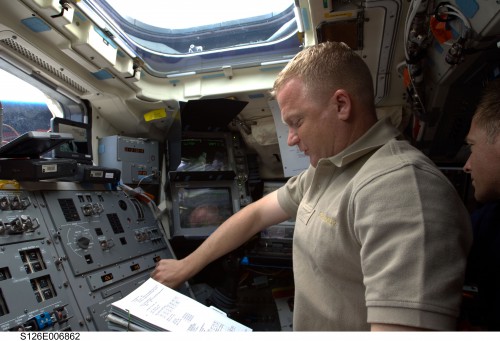
He was at NASA’s Marshall Space Flight Center in Huntsville, Ala., in the late summer of 2007 when he received a call on his cell phone from Chief Astronaut Steve Lindsey. During the course of their conversation, Boe remembered being asked by Lindsey if he would like to fly as pilot on STS-126. It was a question with only one answer. “To get the words that I finally get the chance to go do what I’ve been training for was very exciting to me,” he admitted. The mission was planned for the fall of 2008, with Endeavour slated to transport the Leonardo Multi-Purpose Logistics Module (MPLM) to the International Space Station (ISS) to deliver equipment and supplies—including three additional crew quarters, a second treadmill, a second toilet, food warmers, a refrigerator, and water recycling racks—in readiness for the increase to a six-person permanent capability.
Unfortunately, within weeks of the official NASA announcement, one of the STS-126 crew members, Joan Higginbotham, resigned her place and departed the Astronaut Office for a job in the private sector. She was replaced by veteran ISS astronaut Don Pettit. He and Boe joined Chris Ferguson, the STS-126 commander, and mission specialists Heide Stefanyshyn-Piper, Steve Bowen, and Shane Kimbrough. The flight would bring home Expedition 18 crew member Greg Chamitoff, after six months aboard the space station, and deliver his replacement, astronaut Sandy Magnus.
STS-126 launched at 7:55 p.m. EST on 14 November 2008, kicking off a two-day rendezvous regime to dock with the ISS. During this period, Boe participated in the standard inspection of Endeavour’s surfaces, using the Orbiter Boom Sensor System (OBSS), imaging the starboard wing, then the nose cap and lastly the port wing. Despite a loose thermal blanket, the shuttle was declared to be in excellent shape, and at 5:01 p.m. EST on 16 November Ferguson and Boe brought Endeavour to a smooth docking. They were greeted by the incumbent Expedition 18 crew of U.S. astronauts Mike Fincke and Greg Chamitoff and Russia’s Yuri Lonchakov. Shortly afterwards, Chamitoff and Magnus exchanged their custom-molded Soyuz seat liners, effectively taking their new places as members of the shuttle and ISS crews.
A day into docked operations, the Leonardo MPLM with its 14,000 pounds (6,350 kg) of equipment and supplies was robotically removed from Endeavour’s payload bay and attached to the Earth-facing (or “nadir”) port of the Harmony node. Then, on 18 November, Stefanyshyn-Piper and Bowen—the former a veteran Navy diver, the latter the first Submariner Astronaut—departed the space station’s Quest airlock for almost seven hours on the first of four EVAs to tend to the starboard-side Solar Alpha Rotary Joints (SARJ). These bearing-like joints allowed for the ISS solar arrays to automatically rotate and track the Sun, but since late 2007 the starboard SARJ had exhibited an increase in power consumption. During their spacewalk, Stefanyshyn-Piper and Bowen cleaned and lubricate part of the joint and removed two of its bearing assemblies.
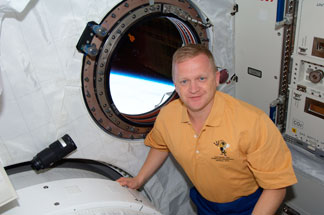
Unfortunately, at one point, one of the grease guns released some grease into Stefanyshyn-Piper’s crew lock bag. As she was cleaning the bag, it drifted away from her and its contents—a pair of grease guns, scrapers, several wipes and tethers, and some tool caddies—were lost, requiring the spacewalkers to complete the rest of their work with a duplicate set from their other crew lock bag. This earned a rebuke from former Soviet female cosmonaut Svetlana Savitskaya, in a 2009 interview, who harshly criticized Stefanyshyn-Piper’s “work-performance defect” and even scornfully remarked that NASA ought to be thankful that the bag was closed and that no instruments were lost.
Two days later, on 20 November 2008—the 10th anniversary of the launch of Russia’s Zarya control module, the first element of the ISS—Stefanyshyn-Piper and Kimbrough ventured outside for EVA-2. They spent more the 6.5 hours relocating equipment, applying lubricant to the Latching End Effector (LEE) of the Canadarm2 robotic arm, and tending to the SARJ issue. Boe served as Intravehicular (IV) crewman for the spacewalk, directing Stefanyshyn-Piper and Kimbrough’s every move. The third EVA, on 22 November, saw Stefanyshyn-Piper and Bowen continue with the cleaning effort, removing and replacing several Trundle Bearing Assemblies, whilst the fourth, on 24 November, saw Bowen and Kimbrough complete the SARJ work.
For Boe, one of the joys of STS-126 was seeing the Atlanta area—his hometown—from orbit. “One of the things that was pretty cool was that they were having a Georgia Tech game and somebody told us as we were flying over,” he told the NASA interviewer. “The shuttle actually flew over the top of Atlanta and we were looking down, while they were looking up, and they actually talked about it at the football game!” Although he wished he could have seen the game itself from his orbital perch, Boe admitted “that would be stretching it a little bit far,” but he was able to discern Atlanta and its city lights.
Extended from 15 to 16 days in duration, STS-126 was targeted to touch down at the Kennedy Space Center’s (KSC) Shuttle Landing Facility (SLF) on 30 November 2008, but the attempt was waved-off by thunderstorms and unacceptably high winds. Instead, NASA managers opted to direct the crew to Edwards Air Force Base, Calif., where Ferguson and Boe executed a textbook landing at 1:25 p.m. PST.
Nine months later, in September 2009, Boe was assigned to his second mission, as pilot of STS-133, which was originally tasked as the final flight of the shuttle era. Planned for launch in September 2010, the crew—with former Chief Astronaut Steve Lindsey in the commander’s seat, joined by mission specialists Al Drew, Mike Barratt, Tim Kopra, and Nicole Stott—would deliver further equipment and supplies aboard the Leonardo MPLM. However, as the shuttle manifest evolved, plans developed to modify Leonardo with additional micrometeoroid shielding and other provisions to become a Permanent Multipurpose Module (PMM). Unlike its previous flights, in which it remained attached to the ISS for just a few days, during shuttle missions, Leonardo’s next mission would see it become a permanent addition to the space station, serving as a “closet” for extra storage volume aboard the steadily expanding orbital outpost.
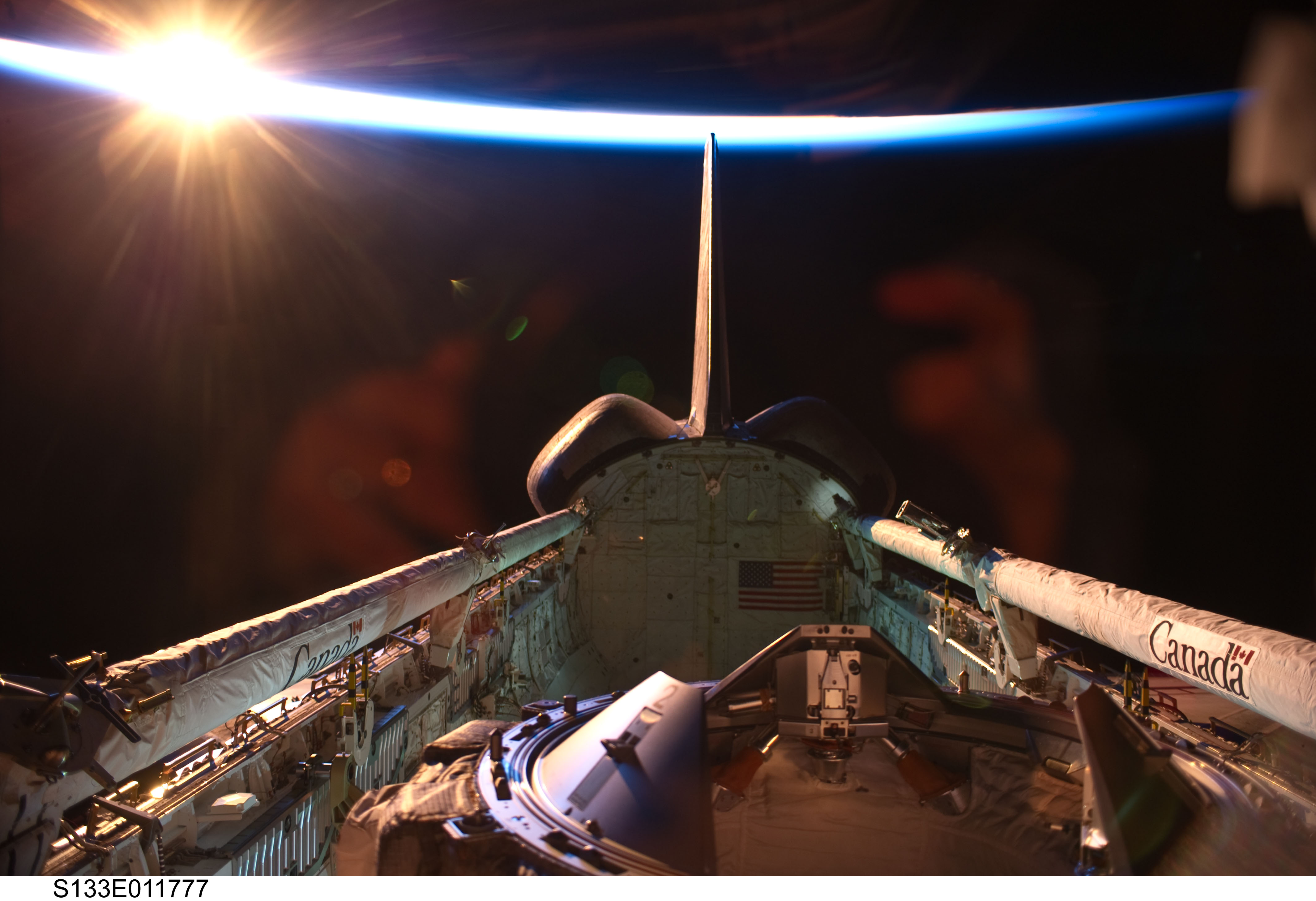
As circumstances transpired, two more missions—STS-134 and STS-135—were added to the shuttle manifest, although STS-133 retained its place in history as the 39th and last flight of the veteran orbiter Discovery. It was a record that Boe was happy to be part of. “Discovery’s had a lot of great firsts,” he told an interviewer. “It’s been the workhorse of the fleet. It’s been on two Return to Flights after Challenger and Columbia. It’s the only orbiter that’s actually flown four missions in the same year. It put Hubble in space. They also went up to Mir for the first time, got up really close to it on the first rendezvous. They didn’t dock with it, but then they also did the last docking with Mir, so it’s had quite a long history.”
By the fall of 2010, STS-133 was tracking an opening launch attempt on 1 November, but fell victim to a lengthy series of technical troubles—leaks from the Orbital Maneuvering System (OMS) and a Ground Umbilical Carrier Plate (GUCP), together with problems with a Main Engine Controller (MEC)—which saw it delayed until late February of the following year and, equally cruelly, saw one of its crew members dropped from the mission. On 15 January 2011, Tim Kopra suffered a bicycle accident near his home and was removed from the STS-133 crew. Since Kopra would have been the lead spacewalker for the mission’s two planned EVAs, it was imperative that an experienced astronaut with recent training should take his place. On 19 January, Steve Bowen took Kopra’s place on STS-133.

Discovery thundered perfectly into orbit at 4:53 p.m. EST on 24 February 2011 and docked at the ISS two days later, whereupon the shuttle crew was greeted by the Expedition 26 crew of U.S. astronauts Scott Kelly and Catherine “Cady” Coleman, Russian cosmonauts Aleksandr Kaleri, Oleg Skripochka, and Dmitri Kondratyev, and Italy’s Paolo Nespoli. The crews set to work with moving the ExPRESS Logistics Carrier (ELC)-4 from Discovery’s payload bay to its berth on the station. This proved an intricate task, with Stott and Barratt controlling Canadarm2 and Boe and Drew handling the shuttle’s own Remote Manipulator System (RMS) mechanical arm.
The first of STS-133’s two spacewalks took place on 28 February, when Bowen and Drew departed the Quest airlock and spent 6.5 hours tending to various tasks outside the ISS. This was followed by the robotic attachment of the Leonardo PMM onto the nadir port of the station’s Unity node, after which Bowen and Drew made a second EVA on 2 March. The closing days of the mission were spent removing cargo from the new module and outfitting it for its new role as a new volume for the ISS and on 7 March Discovery undocked for the final time. Under the deft control of Lindsey and Boe, the orbiter closed out its remarkable career with a pinpoint touchdown at KSC at 11:58 a.m. EST on 9 March.
Completing his second shuttle mission, Eric Boe accrued more than 28 days in space. In late 2011, the post-shuttle Astronaut Office (under then-Chief Astronaut Peggy Whitson) was reorganized with two deputies, with Boe appointed to lead Exploration, Safety, and Astronaut Appearances. A year later, in August 2012, when Whitson stepped down and was replaced by veteran astronaut Bob Behnken as the new chief, Boe became permanent Deputy Chief of the office, a position he continues to hold. His role reportedly encompasses Commercial Crew and, following NASA’s recent decision to award $6.8 billion in Commercial Crew transportation Capability (CCtCap) contracts to Boeing and SpaceX for their CST-100 and Dragon V2 vehicles, Boe’s experience makes him a strong contender to fly one of their early missions in 2017 or beyond.
Whether or not a third space mission comes Boe’s way in the next few years, one feature of his two shuttle flights which has remained with him is the sheer grandeur of Earth. “It’s kind of like when you go on a vacation and you come back,” he said of the gap between STS-126 and STS-133. “Things kind of fade over time. I’m interested to see the colors, the vividness of the planet. You can really see that the Earth is alive and also you kind of get an appreciation for how big the Earth is and at the same time how small we are as compared to the rest of the Universe. We’re used to looking at a globe with borders, but when you’re in orbit, you can see it’s one Earth. And … the people of the Earth are kind of getting together and starting to work more and more together as a group.”
Want to keep up-to-date with all things space? Be sure to “Like” AmericaSpace on Facebook and follow us on Twitter: @AmericaSpace



